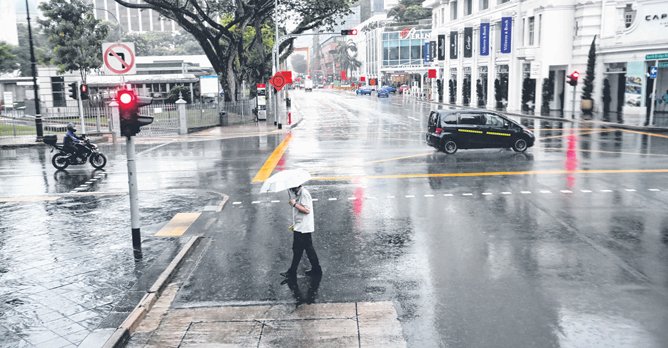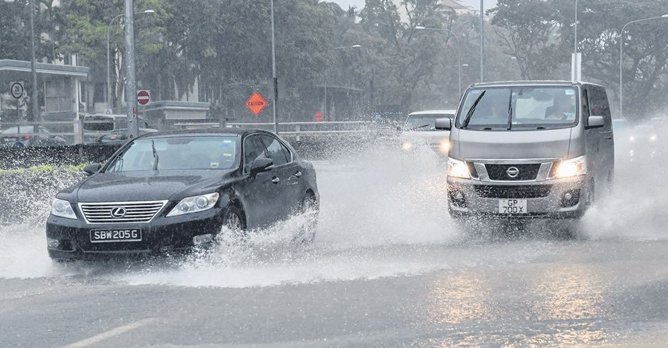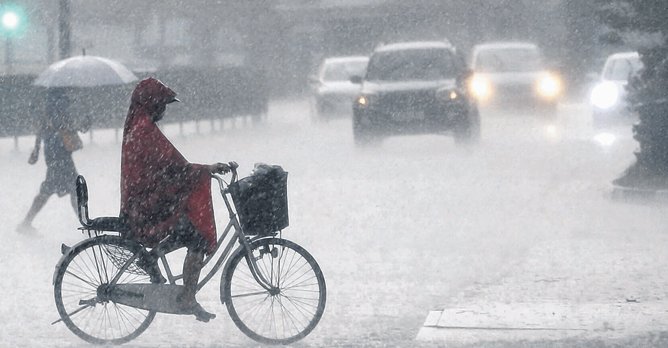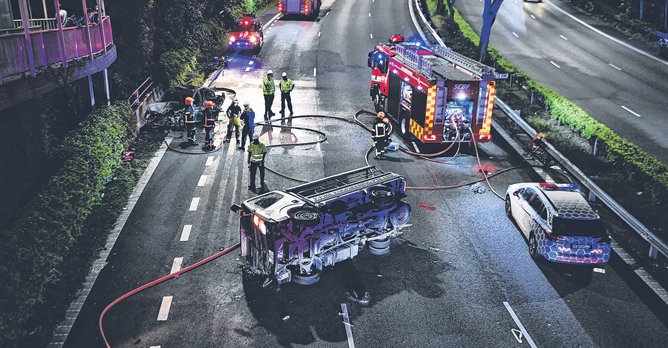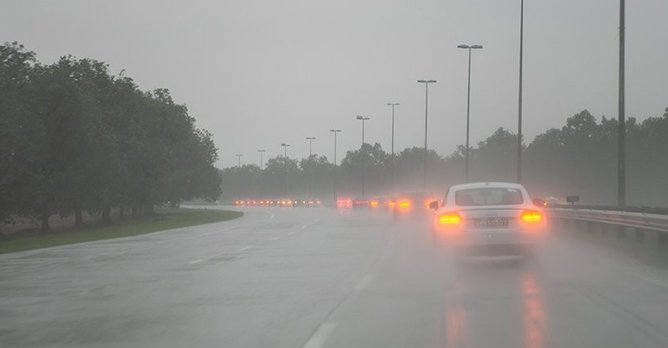Car crashes are always happening on rainy days! But why?
07 Sep 2021|9,163 views
Here it comes! It's the crashing season once again. I mean, raining season, but what's the difference, really? Whenever it rains, the only things you hear across the various radio stations are accidents. In fact, it was reported, back in 2013, that around 30 accidents would occur on average on days with thunderstorms.
Is it simply due to incompetence behind the wheel? Well, we think it's also inexperience, and a poor understanding of how rain makes things precarious on the road. It isn't simply a reduction of grip but, rather, a mix of conditions that amplifies the risk on the roads. Let's find out more about them.
Slippery roads
Wet roads are definitely slicker, that's a no-brainer, you don't need me to tell you that. But you see, the thing is, the slippery-ness, if there's even such a word, vary on different sections of roads.
Dry roads tend to have a consistent coefficient of friction, but when it gets wet, it isn't just the layer of water that works against your tyre's hold on the road. You get debris, oil, algae build-up and all sorts of road grime, resulting in varying levels of grip.
Get caught off-guard by a random slick patch, and you'll lose control of your car possibly leading to a crash. The solution? Use good tyres, drive slower to allow them to do their job of holding to the road surface, and drive carefully.
Hydroplaning
Ever thought that walking on water will be a cool power to have? Well, you can kind of do it with your car, but you really wouldn't want to.
Hydroplaning occurs when your car's tyres can't disperse the water on the road surface quickly enough, and it ends up riding atop the water surface, sort of like a boat.
This will result in a momentary loss of control, and if it happened while you were making a turn, you will likely end up in a wreck. To avoid hydroplaning, you should avoid worn out tyres, and drive at lower speeds.

Sgcarmart
Get up to 20% off and $300 cashback when you renew with select car insurance!
Compare car insurance effortlessly with Sgcarmart. Get exclusive offers, discounts and cashback when renewing car insurance with our partner.
Get a Quote nowDecreased visibility
A mix of the gloomy sky and rain drops on your windscreen means decreased visibility when driving in the rain. But it isn't just that! Throw into the mix, cars that doesn't have their lights turned on, road sprays from cars driving through puddles of water, the reflection of water obscuring road markings, and driving in the rain is now a nerve-wracking experience indeed.
With poor visibility, you wouldn't even know where you are driving towards - you might be heading straight into the back of a truck!
That is why, you should always remember to turn on your car's head lights to ensure visibility, keep your wipers well-maintained, and avoid driving close to heavy vehicles that can churn out enough road spray to totally impede your view of the road.
Erratic behaviour of other drivers
Wet weather results in increased reaction time - poor visibility means you'll take longer to react, and the unfavourable conditions also mean your car will in turn take a longer time to come to a halt.
The worst of it all, is the tendency for drivers to behave erratically in such conditions, be it a sudden slam on the brakes, an unexpected swerve to avoid standing water, or an actual accident unfolding right where your car is heading towards.
Get caught totally off-guard and you might just be involved in an accident with the other drivers.
The point is, while reaction time is increased, such situations force you to react in an even shorter time than usual, which is near impossible. The best thing you can do to protect yourself, is to drive slower so you can have some time to react to the quickly evolving situation.
Of course, you shouldn't be the one making those erratic moves as well, always be cautious with turning and braking in the wet, and keep others safe on the road.
Speeding
Speeding in poor weather conditions increases danger exponentially. The increase in speed along with the increased reaction time means the risks are doubled.
Higher speeds exaggerate the effect of slippery roads, increase the possibility of hydroplaning and give you way lesser time to react to any unexpected situation. The verdict is clear, there's absolutely no reason to speed in the rain, unless you have a death wish.
Instead of speeding, you should be doing the exact opposite, drive slower, and increase your following distance, so the chances of getting yourself caught in the next chain collision can be reduced.

Sgcarmart
Get up to 20% off and $300 cashback when you renew with select car insurance!
Compare car insurance effortlessly with Sgcarmart. Get exclusive offers, discounts and cashback when renewing car insurance with our partner.
- Auto comparison for your future renewal quotes
- We provide claims support for your accident claims
Here it comes! It's the crashing season once again. I mean, raining season, but what's the difference, really? Whenever it rains, the only things you hear across the various radio stations are accidents. In fact, it was reported, back in 2013, that around 30 accidents would occur on average on days with thunderstorms.
Is it simply due to incompetence behind the wheel? Well, we think it's also inexperience, and a poor understanding of how rain makes things precarious on the road. It isn't simply a reduction of grip but, rather, a mix of conditions that amplifies the risk on the roads. Let's find out more about them.
Slippery roads
Wet roads are definitely slicker, that's a no-brainer, you don't need me to tell you that. But you see, the thing is, the slippery-ness, if there's even such a word, vary on different sections of roads.
Dry roads tend to have a consistent coefficient of friction, but when it gets wet, it isn't just the layer of water that works against your tyre's hold on the road. You get debris, oil, algae build-up and all sorts of road grime, resulting in varying levels of grip.
Get caught off-guard by a random slick patch, and you'll lose control of your car possibly leading to a crash. The solution? Use good tyres, drive slower to allow them to do their job of holding to the road surface, and drive carefully.
Hydroplaning
Ever thought that walking on water will be a cool power to have? Well, you can kind of do it with your car, but you really wouldn't want to.
Hydroplaning occurs when your car's tyres can't disperse the water on the road surface quickly enough, and it ends up riding atop the water surface, sort of like a boat.
This will result in a momentary loss of control, and if it happened while you were making a turn, you will likely end up in a wreck. To avoid hydroplaning, you should avoid worn out tyres, and drive at lower speeds.

Sgcarmart
Get up to 20% off and $300 cashback when you renew with select car insurance!
Compare car insurance effortlessly with Sgcarmart. Get exclusive offers, discounts and cashback when renewing car insurance with our partner.
Get a Quote nowDecreased visibility
A mix of the gloomy sky and rain drops on your windscreen means decreased visibility when driving in the rain. But it isn't just that! Throw into the mix, cars that doesn't have their lights turned on, road sprays from cars driving through puddles of water, the reflection of water obscuring road markings, and driving in the rain is now a nerve-wracking experience indeed.
With poor visibility, you wouldn't even know where you are driving towards - you might be heading straight into the back of a truck!
That is why, you should always remember to turn on your car's head lights to ensure visibility, keep your wipers well-maintained, and avoid driving close to heavy vehicles that can churn out enough road spray to totally impede your view of the road.
Erratic behaviour of other drivers
Wet weather results in increased reaction time - poor visibility means you'll take longer to react, and the unfavourable conditions also mean your car will in turn take a longer time to come to a halt.
The worst of it all, is the tendency for drivers to behave erratically in such conditions, be it a sudden slam on the brakes, an unexpected swerve to avoid standing water, or an actual accident unfolding right where your car is heading towards.
Get caught totally off-guard and you might just be involved in an accident with the other drivers.
The point is, while reaction time is increased, such situations force you to react in an even shorter time than usual, which is near impossible. The best thing you can do to protect yourself, is to drive slower so you can have some time to react to the quickly evolving situation.
Of course, you shouldn't be the one making those erratic moves as well, always be cautious with turning and braking in the wet, and keep others safe on the road.
Speeding
Speeding in poor weather conditions increases danger exponentially. The increase in speed along with the increased reaction time means the risks are doubled.
Higher speeds exaggerate the effect of slippery roads, increase the possibility of hydroplaning and give you way lesser time to react to any unexpected situation. The verdict is clear, there's absolutely no reason to speed in the rain, unless you have a death wish.
Instead of speeding, you should be doing the exact opposite, drive slower, and increase your following distance, so the chances of getting yourself caught in the next chain collision can be reduced.

Sgcarmart
Get up to 20% off and $300 cashback when you renew with select car insurance!
Compare car insurance effortlessly with Sgcarmart. Get exclusive offers, discounts and cashback when renewing car insurance with our partner.
- Auto comparison for your future renewal quotes
- We provide claims support for your accident claims






